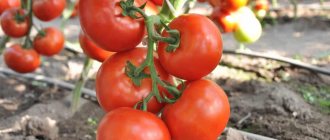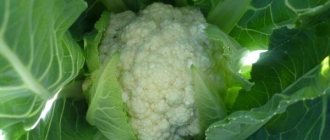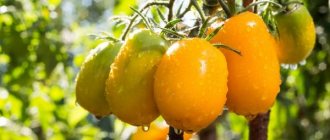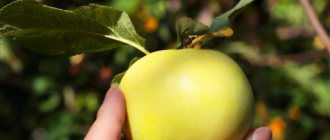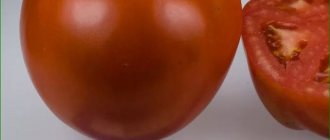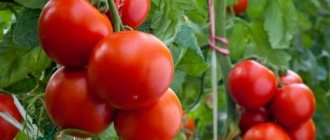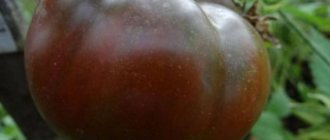Characteristics and description of the variety
The variety was developed by Russian breeder L.A. Myazina. The variety was registered in the State Register in 2009. Recommended for cultivation in the Central Black Earth region, but it is successfully bred in all areas. The Gulliver tomato crop is not the only work of the Russian breeder. In total, the State Register lists 25 varieties and 39 hybrids of her authorship.
Reference . Lyubov Anatolyevna Myazina has been breeding for more than 30 years. Its hybrids are created by hand pollinating two different varieties. This is how the best qualities of the paternal and maternal plants are incorporated into the genes.
Distinctive features
Determinate bush, height – 1.5-1.7 m, medium foliage, medium-sized leaves, simple inflorescences, strong stem. The raceme is simple, unbranched, produces 5-6 fruits. Tomatoes set in any weather conditions.
The variety is early ripening, 100-110 days pass from planting to full ripening. Recommended for cultivation in open and closed ground, drought-resistant and heat-resistant, not afraid of temperature changes.
Productivity is average, per 1 sq. m, up to 6 kg of fruits are collected, provided that 3-4 seedlings are planted per 1 sq. m. m.
It is highly resistant to the main diseases of the nightshade family, such as late blight, blossom end and root rot.
It does not require pinching, but requires mandatory gartering, otherwise the fruit-bearing branches will not withstand the weight of ripe vegetables.
Fruit characteristics
The average weight of tomatoes is 95-115 g, the shape is cylindrical, elongated, reminiscent of a plum. The color is rich red, the flesh is fleshy, practically without liquid. The taste is soft, sweet, with a pleasant sourness. There are 2 seed chambers, few seeds. The peel is thin but dense.
The purpose of ripe vegetables is universal: from fresh consumption to processing for winter preparations. Excellent taste retention in whole-fruit canning. Tomatoes do not crack during heat treatment, which makes it possible to dry the fruits for the winter in the oven at a low temperature. Vegetables are also dried and frozen.
Tomatoes retain their appearance well during long-term transportation and storage for a month.
The photo shows Gulliver tomatoes.
Pros and cons
The main advantages of the Gulliver tomato include:
- compactness of plants;
- fruit setting in all weather conditions;
- Gulliver tomato fruits are approximately the same size, smooth with a beautiful presentation and good taste;
- resistance to periods of drought and heat;
- high resistance to major diseases characteristic of other tomato varieties;
- excellent taste of Gulliver tomato;
- The collected fruits tolerate transportation well at any distance and can be stored for up to a month after collection.
Among the disadvantages of the Gulliver tomato, it should be noted:
- relatively low productivity in open ground;
- the ability to grow only in a certain region.
How to grow seedlings
Sowing seeds for seedlings begins 2 months before planting in the ground. Before sowing, the seeds undergo special treatment to improve germination.
Seed preparation
Planting material is checked for germination by placing the grains in a saline solution for 10 minutes. Seeds that float to the surface are not suitable for planting.
Seeds collected independently are subject to mandatory disinfection before sowing. To do this, they are placed in a weak solution of potassium permanganate for 20 minutes.
Reference . Seed material purchased from a specialized store does not need to be processed. The originator took care of everything himself.
After disinfection, the grains are washed with running water, wrapped in gauze, slightly moistened and left in a warm place for 2-3 days for germination. The room temperature must be at least 23°C. After the sprouts appear, the grains are ready for sowing.
Reference . Gulliver tomato seeds are produced by Agro and Siberian Garden.
Container and soil
The soil mixture is prepared from garden soil, humus and wood ash. All components are thoroughly mixed and poured with a hot solution of pink potassium permanganate to destroy pathogenic flora.
They are planted in separate containers or in a common wooden box, in which holes are first made in the bottom so that when watering there is no stagnation of excess moisture. If you sow seeds directly into peat pots, there is no need to pick seedlings later. In addition, during transplantation, seedlings are planted in the ground along with peat pots, which dissolve in the soil without harming the root system.
Planting containers are filled halfway with prepared soil. Later, as the young bushes grow and develop, the remaining soil is poured into the containers. This way the seedlings receive more nutrients.
Sowing
The seeds are sown in furrows 1.5-2 cm deep, making the row spacing 3 cm. If the grains are sown shallow, they will germinate along with the shell, which will slow down their further growth. After sowing, the soil is slightly moistened with a spray bottle and left in a warm and bright room at a temperature of at least 22°C. Planting containers are covered with film or glass to create a greenhouse effect.
Growing and care
After the first shoots appear, the containers are moved to a more illuminated place, for example, on a windowsill.
Reference . Avoid exposure to direct sunlight. Young shoots can suffer serious burns.
Water as needed with warm, settled water using a shallow watering can along the edge of the nursery. After watering, the soil is loosened superficially for better oxygen saturation.
When 2 true leaves appear, the seedlings are picked and placed in separate containers. If the seedlings are left in a common box, the distance between plants is maintained at least 10 cm. After picking, the seedlings are shaded for 1-2 days, then moved again to a well-lit place.
2 weeks before planting in open ground, seedlings begin to harden. This technique strengthens the immunity of seedlings and promotes faster adaptation to outdoor conditions. The hardening process involves keeping the seedlings outdoors for 25-45 minutes every day. Gradually, this time is increased to 12 hours, while simultaneously reducing the night temperature in the room where the seedlings are brought to 13°C.
Characteristics of tomato
The rapid ripening of aromatic Gulliver tomatoes, according to reviews, makes them attractive to housewives who are engaged in winter preparations.
Productivity and fruiting
The originator of the variety indicates that tomatoes are ready for harvest 100 days after sprouting. Gulliver tomatoes ripen by the end of July or the beginning of August. Subject to the requirements of agricultural technology, up to 4 kg of tomatoes are harvested from the bush. During tests from 1 sq. m received from 22 to 69 kg of Gulliver fruits. In open ground, the amount of harvest may be slightly smaller, but the taste of tomatoes ripened in the sun is better. Timely watering, fertilizing, removing weeds, and correct, sparse planting help increase the harvest of Gulliver tomatoes.
Area of application of fruits
Due to the dense structure, tomatoes of this variety last a long time, up to a month. Gulliver tomatoes are suitable for salads and sandwiches: they retain the shape given to the slices and do not leak juice. The fruits are convenient for whole preservation and pickling. They are processed for ketchup and thick sauces. The amount of dry matter allows the fruits of the Gulliver variety to be dried and frozen.
Resistance to diseases and pests
Gulliver tomatoes ripen quite early and are almost never at risk of being infected with late blight. Plants are resistant to rot: root and apical. To protect the crop from common other fungal diseases, plants are planted sparsely and prevention is used by spraying 2 times with fungicides or weekly with folk remedies. Tomatoes in greenhouses are plagued by aphids and whiteflies. In open ground, plants are protected from Colorado potato beetles.
Advantages and disadvantages of the variety
Based on the description of Gulliver tomatoes, we can conclude that the variety has many advantages:
- attractive and original shape of the fruit;
- dense pulp texture;
- pleasant taste;
- long-term storage and transportability;
- unpretentiousness and adaptability to changeable weather conditions;
- drought resistance;
- resistance to a number of fungal diseases.
In reviews of the Gulliver tomato, gardeners emphasize that the disadvantages of the variety include:
- low yield;
- narrow area of zoning.
How to grow tomatoes
After 2 months, the seedlings are ready to be transplanted into the ground. They are transplanted into open beds in late May - early June, when the threat of night frosts has passed.
Landing
The soil for tomatoes is prepared in the fall. The soil is dug up and organic matter or a complex of mineral fertilizers are added. Tomatoes grow well in those beds where legumes, onions, cucumbers, and cabbage previously grew.
Planting pattern: 70 cm – distance between seedlings, 40 cm – row spacing.
A little wood ash is added to prepared holes 15 cm deep and watered generously. After replanting, the soil is well compacted, watered again, the beds are loosened and hilled. It is best to replant in the evening or on a cloudy day - this way the young bushes are more likely to adapt to new conditions.
Reference . To quickly grow green mass, place 1 teaspoon of ammonium nitrate in each hole.
Further care for tomato Gulliver
As the seedlings adapt to new conditions, regular watering is established. Water abundantly, but not often. In normal weather, 3-4 liters of warm, settled water are poured under each bush, strictly under the root, without getting on the leaves. On dry days, the amount of watering is increased, making sure to control the level of humidity in the beds. Overmoistening of the soil leads to the development of fungal diseases.
After each watering, the soil is loosened, hilled up and weeds with roots are removed. These simple methods promote better penetration of oxygen to the roots and protect plants from many pests.
To keep the beds moist longer, they are mulched. This is especially important on hot days when moisture evaporates faster than usual. In addition, mulch protects the beds from pests moving underground, which are dangerous because they disrupt the root system of plants.
Fertilizing is carried out 3 times during the entire growing season. The first feeding is given during flowering, the second during the formation of ovaries, and the third time during fruiting. A complex of mineral fertilizers or organic matter is well suited as fertilizing. Mullein infusion and bird droppings are used as organic matter in a ratio of 1:15.
Features of cultivation and possible difficulties
The bushes require obligatory garter, otherwise they will begin to break under the weight of the weight of the fruit. To do this, install wooden stakes or metal rods next to each bush. The bushes are fixed to the support immediately when transplanted into the ground. Due to timely gartering, a strong and even stem is formed. As the fruiting branches grow and develop, they are also fixed to the support.
The plant does not require constant pinching, which significantly simplifies care during the growing season. At the beginning, to improve fruiting, the plant is formed into 2 or 3 stems, removing all excess stepsons. This technique allows you to get maximum yield.
Diseases and pests
Tomato Gulliver is not prone to diseases that often affect the nightshade family. But still, some crop rotation rules will further protect the crop from possible infections.
It is not recommended to place tomato beds next to potatoes. This is because the plants belong to the same family and suffer from the same diseases and pests. The plantings are not thickened so that all bushes receive the same amount of light and are regularly ventilated.
In rainy summers, plants are sprayed with “Fitosporin” or copper sulfate to prevent late blight. Late blight is a fungal disease; high humidity is a prerequisite for its spread.
The most common pests are aphids, whiteflies and Colorado potato beetles. Treating the stems with a soap solution helps prevent aphids. All plants with a large concentration of parasites are sprayed with the same solution. The Colorado potato beetle is collected by hand along with its larvae.
The larvae are usually found on the inside of the leaves, so when inspecting plants it is necessary to carefully inspect the leaves on both sides. Pheromone traps, which can be purchased in specialized stores, save you from whiteflies.
Reference . Pheromone traps capture only parasites, without causing harm to other insects that are not pests.
Also preventative is spraying plants with decoctions of sharp-smelling herbs: burdock, calendula, onion peels, onions, garlic. Planting calendula, marigolds and mustard next to tomatoes saves the crop from many parasitic insects that do not approach the beds due to the pungent odor of the herbs.
Pest and disease control
Judging by the reviews, the Gulliver tomato variety is rarely affected by diseases. To exclude them, the greenhouse is constantly ventilated after watering and maintains optimal temperature and humidity. In the garden, plantings are not thickened, and a plot with tomatoes is not placed next to potatoes. These crops have the same diseases and pests. In case of a rainy summer, tomatoes are sprayed prophylactically with copper-containing or folk remedies. Good effect from Fitosporin-M.
Tomatoes are plagued by aphids, whiteflies, and Colorado potato beetles, against which insecticides are used.
The nuances of growing in open ground and in a greenhouse
The tomato is recommended for cultivation in the Central Black Earth region, but it is successfully grown in all regions, including the northern ones. Tomatoes are planted under film shelters earlier than in open ground, for 2-3 weeks, depending on weather conditions.
In the greenhouse, during flowering, the bushes are slightly shaken so that the empty flowers fall off and pollination becomes complete. As it grows, the bush is formed into 2 stems, and when planted sparsely, 3 stems are left. The lower leaves must be removed to prevent the development of fungal spores.
The height of the plant depends on the fertility of the soil and climatic conditions. Thus, in the Urals or Siberia, growth does not exceed 60 cm. Consequently, the quantitative indicator will be lower than with full development.
In fertile soil in warm regions where the crop is grown in open ground, its height reaches up to 1.7 m. To limit the growth point, the crown of the plant is pinched.
In cold regions, the crop is grown only in greenhouses or under film cover. In closed structures, the risk of developing infections is higher than in open beds. This is due to constantly increased temperature and humidity. Therefore, the greenhouse must be regularly ventilated to destroy the pathogenic environment. But do not forget that drafts have a detrimental effect on tomatoes.
Features of growing tomato Gulliver
Tomato Gulliver is recommended to be grown only in seedlings. It must be remembered that seedlings are planted in a permanent place at the age of 2 months.
It is recommended to sow Gulliver tomato seeds for seedlings at home in the following periods:
- for transplanting into a greenhouse - in the first ten days of February;
- for planting in film greenhouses - in the first ten days of March;
- for growing Gulliver tomato in a garden in open ground - in the last ten days of March or in the first ten days of April.
Harvesting and application
The ripening of fruits is friendly - this is an important distinguishing feature of Gulliver. It is not necessary to wait for vegetables to fully ripen; they can gain color on their own at room temperature within a few days. Placing unripe tomatoes next to ripe ones will speed up the time for self-ripening.
At an air temperature of +10°C and below, vegetables are harvested green. Cold nights promote the development of fungal diseases and rotting vegetables. In any case, tomatoes in the garden beds will not be able to ripen at this temperature.
Universal use in cooking. Ripe vegetables are ideal for fresh salads and other vegetable dishes. Smaller tomatoes are used in whole-fruit canning. They do not lose their taste in pickles and marinades and are excellent for making tomato products: paste, ketchup, sauces, juices.
An important property of ripe vegetables is that they can withstand heat treatment without cracking. Thanks to this, they are dried in the oven at low temperatures or in the sun. Tomatoes are also dried and frozen.
Tomatoes are subject to long-term storage for 4 weeks without loss of external and taste qualities. Excellent resistance to long-term transportation.
Tomato care
Tomatoes are grown from seedlings, taking into account that the optimal age at planting is 55-60 days.
How to grow strong seedlings
Seeds must be treated before sowing:
- soak in a solution of potassium permanganate (no more than 15-20 minutes);
- sprouted in a cloth or damp cloth.
Gardeners practice soaking tomato seeds in growth stimulants, which improves plant germination and improves immunity. Among the purchased drugs, Zircon, Epin, Energen are effective; you can prepare an infusion of ash or an extract of aloe juice yourself. Everyone decides for themselves whether to carry out all the procedures or limit themselves to germination only.
Seeds are sown in different ways: in general containers and then planted in pots and cups. It is also practiced to sow in separate pots, but first they take small-volume containers, and then, using the transfer method, plant the plants in larger containers.
Nutrient soil for seedlings is prepared in advance, storing the soil in the fall. Soddy soil is suitable, which is mixed with peat, adding a baking powder (sand, vermiculite). Proportions: 2:2:1.
The soil must be calcined, disinfected with a solution of potassium permanganate (use a saturated purple solution), and allowed to stand for 2-4 days. Then add humus, superphosphate (a matchbox on a bucket), and ash.
Tomatoes of the Gulliver variety are sown as seedlings in March, so that the plants can be planted in beds or greenhouses at the beginning of May. When choosing sowing days, keep in mind that it takes 4-7 days for seeds to germinate.
As soon as the shoots appear, the temperature is lowered to +18ºC, the plants are kept for about 5-6 days, and then gradually increased. Optimal values for tomatoes are +23ºC…+24ºC, at night they can be reduced to +19ºC…+20ºC.
On cloudy days in March, seedlings are illuminated using fluorescent lamps or special phyto-lamps.
Watering is moderate, with the addition of crystals of potassium permanganate (from blackleg) to warm water.
Tomatoes peak when they have 2-3 true leaves. After the procedure, the bushes are shaded from the sun for 2-3 days.
Before planting in open ground, tomatoes are fed twice with nitrophoska or a special fertilizer for seedlings (Kemira).
Before planting, tomatoes are hardened by placing them on a loggia or veranda. The procedure time at the very beginning is 15-20 minutes so that the plants do not experience stress. Then the duration is gradually increased, bringing it to several hours. Seedlings are placed in beds or greenhouses when the weather is warm and the soil is completely warm (+14ºC…+16ºC).
Agricultural technology of tomatoes
The plots are prepared in the fall, filling the soil with humus and carefully digging it up. Prepare the holes 2-3 days in advance, add humus and superphosphate (a spoonful at a time), and before planting, pour them well with warm water. The variety is planted with 4-5 plants per square meter; up to 6 plants are allowed in a garden bed.
The tomatoes are not watered for about 6-8 days, giving time to adapt and form the root system. For plants in the beds, already at this time it is advisable to mulch the soil with hay, humus, and peat.
Water rarely, abundantly, thoroughly soaking the soil around the bushes. For watering, it is advisable to make grooves and holes so as not to erode the soil around the stem and not expose the roots of the tomatoes. Watering for tomatoes in the beds is carried out taking into account precipitation, avoiding excessive soil moisture.
Feeding begins 18-20 days after transplantation, taking into account the growing season of a mid-season tomato. The first feeding includes mullein diluted in water and a green infusion of fermented grass.
During the budding stage, tomatoes need phosphorus and potassium, so superphosphate and ash infusions are added to the fertilizer. During the season, Gulliver is fed 3-4 times, alternating foliar application of fertilizers (spraying) and root application.
Recommendations for increasing yield:
- treatment of tomato bushes with iodine composition;
- spraying the bushes with a solution of sodium humate (carried out during the flowering period of plants);
- shaking the bushes at the time of flowering (in the morning, for better pollination);
- treatment of plants with special preparations “Ovary” and “Bud”.
Medium-early tomato ripening allows it to avoid late blight. But gardeners, trying to get a high yield, carry out mandatory preventive measures:
- treatment of tomatoes with Bordeaux mixture (use 1% solution);
- spraying with Epin, a composition with boric acid, whey);
- spraying with infusions of crushed garlic and potassium permanganate.
Treatments for tomatoes growing in open ground are mandatory. In cool and rainy summers, late blight appears very early (gardeners in the North-West especially suffer from it), so early prevention will save plants from this insidious infection, and therefore protect the harvest.
When the first signs of the disease appear, the affected bushes are removed and the plants are treated with special chemicals.
A number of techniques will help prevent illness:
- compliance with the tomato planting scheme;
- eliminating excess fertilizers (especially nitrogen, when tomatoes grow wildly and produce a small number of ovaries);
- proper watering;
- using mulch;
- rotation of crops when planting in the garden.
Gulliver's fruits begin to be harvested in early July, and since this is a long-bearing variety, the latter are harvested in the fall. If you plan to take seeds, then choose the most beautiful tomatoes, leaving them on the bushes until they are completely ripe. It is recommended to pick other fruits when they are green or brown, so that all the tomatoes on the bushes have time to form.
The Gulliver variety is known to many gardeners. Its “strengths” are high productivity, unpretentiousness, and excellent taste of the fruit.
Advantages and disadvantages
The variety has many advantages:
- survival rate in all regions;
- good adaptation to temperature changes;
- high resistance to diseases;
- fruit set under any climatic conditions;
- does not require pinching;
- ease of care;
- good yield;
- early maturation;
- excellent taste;
- unusual shape;
- versatility in cooking;
- long-term storage;
- long transportation;
- the ability to independently select seeds for planting.
The only disadvantage of culture is the mandatory garter.
Reviews about the variety from those who planted
The tomato variety "Gulliver" is loved by most gardeners. The tomato has captivated farmers with its ease of care, excellent immunity, and excellent taste characteristics.
Tomato "Gulliver" will be an excellent choice for owners of personal plots. As with growing any tomato variety, “Gulliver” needs timely feeding and staking. If you provide additional care, you will certainly be surprised by a good harvest.
Review from a gardener:
Farmer reviews
Despite the stated limitation of regions where the species can take root and produce a good harvest, reliable reviews come from different areas, which indicates the high ability of the tomato to adapt to any weather conditions. Opinions of gardeners who planted this crop:
Nikolay, Yekaterinburg: “The description says that tomatoes can only be grown in the Central Black Earth Region. I decided to take a risk. I sowed 5 seeds and they all sprouted. The seedlings grew well. After planting in the ground, the bushes quickly adapted. They did not require any special attention other than normal care. Almost all the flowers bore, there was a lot of fruit. I will grow more."
Violetta, Barnaul: “I grow various vegetables, including tomatoes. I buy Gulliver seeds. Tasty, neat fruits are enjoyed fresh or canned. I didn’t observe any diseases during the growing season.”
Agricultural technology
Growing Gulliver tomatoes is not difficult. To get a good harvest, you just need to follow simple rules for caring for the plant.
Sowing seeds
The crop is grown by seedlings. Seeds are sown 50-55 days before the intended planting in a permanent place (in a greenhouse or open ground). It is impossible to name the exact sowing time, since planting times are different in different latitudes.
Before sowing seeds, you need to prepare the soil. Soil for plants is sold in stores, but it is better to prepare it yourself, using soil from the bed on which the crop will subsequently grow as a basis.
Additional compost or humus and ash are added to the soil from the garden bed and disinfected with a weak solution of potassium permanganate. Seeds are planted in prepared moist soil in increments of approximately 2 cm to a depth of 1-1.5 cm.
ADVICE! The seeds do not need to be planted in the ground, but sprinkled on top with a layer of soil.
After planting, the soil is moistened again so that there is no stagnation of moisture, and covered with glass or film. The container with the seeds should be placed in a warm, bright place.
Seedling care
The first shoots hatch already 4-5 days after planting. As soon as they appear, the container must be opened immediately so that the sprouts do not grow tall. Elongated plants are too brittle and weak.
After germination, the container is placed in a lighted place so that direct sunlight does not fall on the plants, but the temperature must be reduced for several days. Watering is done as needed. The most important thing is that the top layer of soil is moist, but not stagnant.
As soon as the first two true leaves appear, the seedlings are picked. You can plant one plant at a time in any small containers, for example, plastic cups. Then the seedlings are placed in a lighted place.
IMPORTANT! The soil for seedlings is prepared in the same way as for seeds.
2-3 weeks before planting in a permanent place, seedlings need to begin to harden. To do this, containers are taken outside. The first time is for 20-30 minutes. Gradually the duration of the “walks” is increased. It is important to ensure that direct sunlight does not fall on the plants.
Caring for mature plants
The soil for the crop is prepared in the fall. The beds are dug up with organic and mineral fertilizers. About two weeks before planting the plants in the spring, the beds are dug up again, holes are made and watered with a solution of potassium permanganate.
Seedlings are planted at a distance of 50-70 cm. When planting, a peg with a height of at least 1.8 m is immediately placed next to the sprout. Further care consists of the usual actions:
- timely watering. Despite the fact that the variety is drought-resistant, with sufficient moisture it will bear fruit better;
- as necessary, the soil is loosened to supply the roots with oxygen and weeds are removed;
- fertilizing with mineral fertilizers is carried out 3-4 times during growth;
- tearing off the lower leaves and tying the stems to supports as they grow.
IMPORTANT! There is no need to plant the plant.
The bush is formed into two stems so that there is no heavy load on the plant. Reducing the stems will only have a better effect on the quantity and quality of the crop. When grown in a greenhouse, it must be ventilated periodically. For late blight, the bushes are treated with preparations containing copper, and the plant is not susceptible to other diseases.
Raspberry hussar - description of the variety, care, cultivation, characteristics, planting and harvesting rules (65 photos)
Preventative treatment
As the manufacturers state in the description, as well as according to reviews from growing experts, the Gulliver tomato has good resistance to various diseases, provided that the rules of care are followed. But prevention is still recommended.
It consists of removing the lower leaves, preventing high humidity, and watering strictly to the root. Make sure that tomato bushes are not located near potato plantations.
Good results are obtained by periodically spraying with a solution of boric acid (1 g of acid per 1 liter of water), but always in the evening. Baking soda can be used in a similar way.
For harmful insects, you can use infusions of plants, the smell of which repels. These include tansy, wormwood, and dandelion. You can also plant marigolds, calendula or other cultivated plants with a strong aroma around the tomato bed.
When the first signs of disease appear in tomatoes, it is necessary to carry out chemical treatment, strictly observing safety precautions.
“Gulliver” tomatoes, which relatively recently appeared on the seed market, have found their admirers. If all the requirements were met, gardeners received a good harvest of tomatoes, which are good both fresh and in pickles and sauces.
Therefore, buy real “Gulliver” seeds, grow seedlings yourself and get delicious tomatoes. Good luck with your gardening!
About the formation of determinate tomatoes on video
If you grew Gulliver tomatoes, please write whether you liked them or not.
What was the yield and taste of the fruits in your climatic conditions? Will you grow them again? How do you rate the disease resistance of this variety? Briefly describe what, in your opinion, are the advantages and disadvantages of this tomato. If possible, attach a photo of the entire bush or individual fruits you grew to your comment. Thank you!
Your reviews of the Gulliver tomato and additions to the description will help many gardeners evaluate this variety more objectively and decide whether it is worth growing or not.
Technical data of the plant and fruit
Gulliver tomatoes have the following characteristics and description:
- The variety ripens in medium terms. Its growing season lasts about 100 days. Breeders have bred 2 species of this plant - Gulliver F1 and Gulliver's Heart.
- The average height of a plant bush varies between 0.6-0.7 m. In greenhouses, bushes grow up to 120 cm.
- The stems have a moderate number of leaves. To obtain maximum yield, the bush is formed from 2 or 3 stems. There is no need to remove shoots when growing tomatoes.
- The plant develops a simple inflorescence with 5 or 6 fruits.
- The fruits are shaped like peppers. They have 2 chambers with a small amount of seeds. The diameter of the berry reaches 40-50 mm, and the length is about 12 cm.
- The weight of the fruit ranges from 90 to 120 g, but when grown in a greenhouse, the gardener most often receives berries with an average weight of 0.2 to 0.4 kg. Feedback from farmers shows that if all the requirements of specialists are met, you can get tomatoes weighing from 0.8 to 1.0 kg. Therefore, the bushes need a garter, otherwise their branches will break from the weight of the fruit.
- The skin of the tomato is thick and red. It prevents the berries from cracking.
As practice shows, Gulliver's yield, if the plant is planted in an open area, ranges from 3.5 to 4 kg of berries per bush. Growing tomatoes in greenhouse blocks allows you to increase this figure to 7 kg per plant. Gulliver is resistant to diseases such as late blight, root or blossom end rot. The plant tolerates short-term temperature changes well.
Description of fruits
A distinctive feature of the variety is the appearance of the fruit - they have a cylindrical shape with uneven bulges and a pointed tip. Most ripe tomatoes of this variety on the vine are identical in size. Gulliver's fruits reach 10-12 cm in length with a diameter of 4-5 cm. Each tomato weighs from 70 to 100 g.
Oblong tomatoes have 2 seed chambers and fleshy pulp. Each contains a small amount of seeds. Due to the dense structure, when Gulliver is cut, practically no juice flows out of it. The taste of the fruit is sweetish with a slight sourness.
